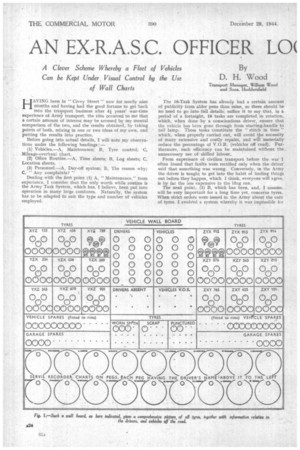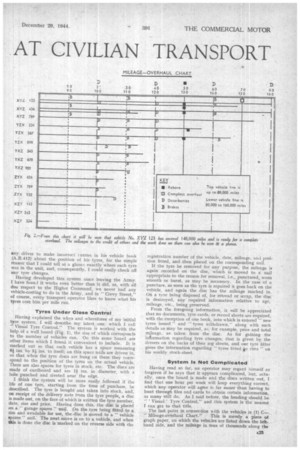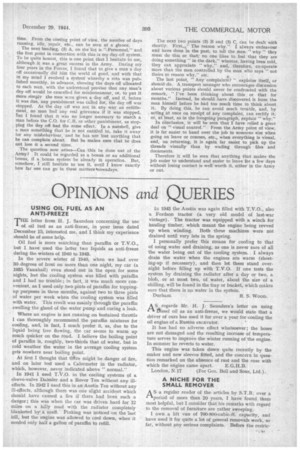AN EX-R.A.S.C, OFFICER L0(
Page 26

Page 27

Page 28

Page 29

If you've noticed an error in this article please click here to report it so we can fix it.
AT CIVILIAN TRANSPORT
HAVING been in " Civvy Street " now for nearly nine Months and having had the good fortune to get back into the transport business after 9i years' war-time experience of Army transport, the idea occurred to me that a certain amount of interest may be aroused by my mental comparison of the two, and the results obtained, by taking points of both, mixing in one or two ideas of my own, and putting the results into practice.
Before going into actual details, I will note my observations under the following headings:— (1) Vehicles.—A, Maintenance; B, Tyre control; C, Mileage-overhaul chart.
(2) Office Routine.—A, Time sheets; B, Log sheets; C. Location sheets.
(3) Personnel.—A, Day-off system; B, The reason why; C, "Any complaints? "
Dealing with the first point (1) A, "Maintenance." from experience, I consider that the only worth while routine is the Army Task System, which has, I believe, been put into operation in many large combines. Naturally, the system has to be adapted to suit the type and number of vehicles employed. The 16-Task System has already had a certain amount of publicity from abler pens than mine, so there should be no need to go into full details'; suffice it to say that, in a period of a fortnight, 16 tasks are completed in rotation, which, when done by a conscientious driver, ensure that the vehicle has been gone through from starting-handle to tail lamp. These tasks constitute the " stitch in time" which, when properly carried out, will avoid tine necessity of many extensive and costly repairs, and will materially reduce the percentage of V.O.R. (vehicles off road). Furthermore, such efficiency can be maintained without the unnecessary use of skilled labour.
From experience of civilian transport before the war I often found that faults were rectified only when the driver said that something was wrong. Conversely, in the Army the driver is taught to get into the habit of finding things out before they happen, which I think, everyone will agree, is by far the less expensive in the ldng run.
The next point, (1) B, which has been, and,. I assume, will be very important for a long time yet, concerns tyres. When strict orders were issued in the Army about the care of tyres, I evolved a system whereby it was impossible for any driver to make incorrect ,ntries in his vehicle hook (A.B.412) about the position of his tyres, for the simple reason that I could tell at a glancc exactly where each tyre was in the unit, and, consequently, I could easily check off any tyre changes.
Having developed this system since leaving the Army. I have found it works even better than it did, as, with all due respect to the Higher Command, we never had any vehicle-costing to do in the Army, and in " Civvy Street," of course, every transport operator likes to know what his tyres cost him per mile run.
Tyres Under Close Control Having explained the whys and wherefores of my initial tyre system. I will describe my latest one, which I call Visual Tyre Control." The system is worked with the help of a wall board (Fig, I), the size of which corresponds to the number of vehicles run. On this same board are other items which I found it convenient to inclade. It is marked out so that each vehicle has a space measuring 6/ ins, by 5i ins, to itself; on this space nails are driven in, so that when the tyre discs arc hung on them they correspond to the position of the tyres on the actual vehicle. There are also spaces for tyres in stock, etc. The discs are made of cardboard and are I ins, in diameter, with a hole punched and riveted near the edge. , I think the system will be more easily followed if the life of one tyre, starting from the time of purchase, be described. The tyre is bought and taken into stock, and, on receipt of the delivery note from the tyre 'people, a disc is made out, on the face of which is written the tyre number, date, size and price. Having done this, the disc is placed on a "garage spares" On the tyre being fitted to a rim and available for use, the disc is moved to a "vehicle spares" The next move is on to a vehicle, and when this is done the disc is merited on the reverse side with the registration number of the vehicle, date, mileage, and posi• tion fitted, and then placed on the corresponding nail.
If the tyre be removed for any purpose, the mileage is again recorded on the disc, which is moved to a nail appropriate to the reason for removal, i.e., punctured, worn smooth or burst, as may be necessary. In the case of a puncture, as soon as the tyre is repaired it goes back on the vehicle, and again the disc has the mileage marked in. On a tyre being disposed of, for retread or scrap, the disc is destroyed, any required information relative to age, mileage, etc., being preserved.
From the foregoing information, it will be appreciated that no documents, tyre cards, or record sheets are required, with the exception of one book, into which is entered "new tyres issued " and "tyres withdrawn," along with such details as may be required, as, for example, price and total mileage. as taken from the disc. As for gaining the information regarding tyre changes, that is given by the drivers on the backs of then log sheets, and oer tyre fitter gives the information regarding " tyres fated to rims " on his weekly stock-sheet.
System Is Not Complicated Having read so far, an operator may regard himself as forgiven if he says that it appears complicated, but, actually, once the board is made and the discs written out, find that one hour per week will keep everything correct, which any operator will agree is far easier than having to hunt through files and cards to obtain certain information, as many stilt do. As I said before, the beading should be Visual' Tyre Control," and this system is the nearest I can get to that title.
The last point in connection with the vehicles is (1) C
" Mileage-overhaul Chart." This is merely a piece of graph paper, on which the vehicles are listed down the lefthand side, and the mileage in tens of thousands along the
top. This chart (Fig. 2) should he used in conjunction with the maker's handbook. The overhauls and other items for which there is a mileage Emit should be entered above the mileage at the top of the sheet and a red line should be drawn vertically down the sheet, under the mileage figure for the overhaul.
The mileage is entered every month by inking in a line, parallel to the vehicle number, and as soon aS this line approaches any of the lines indicating any overhaul, arrangements can be made for the vehicle to visit the repair shop. In the event of any job being done before, ' or after, the correct mileage, a symbol may he used to indicate the fact Reference to the diagram should clarify the foregoing explanation. Again, it will be seen that visual control plays a major part in the scheme.
We now come to (2) ".Office Routine,'; and item (2) A is "Time Sheets." Included on my tyre board are pegs, on which I put the Servis Recorder charts—one peg for each driver. MI the charts are stamped before use, .then, when the log sheets are checked the next morning, the driver's time is put in the space provided. Under this is put the actual time wOrked by the vehicle, and in the last any difference between the two; actually, the total time worked is found by totalling up the differences, if any, and adding this figure or subtracting it from the tune claimed by the driver, the result being put in the " Total Vehicle Time " column.
To offset any claim for starting difficulties, or working on the vehicle after it has been garaged, the drivers enter any relevant details on the back of the log sheet, and this time is added to the total. In addition, 20 minutes' garage time is allowed per day per man, and so the amount of overtime, plus 20 minutes garage time, plus time actually working, are all noted nit the Servis Recorder chart, and remain a permanent record. Before pay-day the times are noted in the time book, which is given to the person making up the wages. In the event of any query, the chart can be looked up and, in conjunction with the log
time. From the costing point of view, the number of days running, idle, repair, etc., can he seen at a glance.
The next heading, (3) A, on the list is "-Personnel," and the first point in connection with this is my day-off system. To be quite honest, this is one point that I hesitate to use, although it was a great success in the Army. During my four years in the Forces. I found that to give a man a day off occasionally did him the world of good, and with that in my mind I evolved a system whereby a rota was published monthly, in advance, showing the days off allocated to each man, with the understood proviso that any man's day off would he cancelled for misdemeanour, or, to put it more simply the men wr..re given a day off, and if, before it was due, any punishment was called for, the day off was stopped. As the day off was not in any way an entitlement, no man had any real grievance if it was stopped, tut I found that it was no longer necessary to march a man before the C.O. for C.B. or other punishment, as stopping the day off had the same effect. In a nutshell, give a man something that he is not entitled to, take it away for any misbehaviour, and he has not lost anything that he can complain about. But he makes sure that he does not lose it a second time.
The question now arises—Can this be done out of the Army? It could be regarded as a bonus or an additional bonus, if a bonus system be already in operation. But, somehow, I still hesitate to use it, until I know exactly how far one can go in these matters ■nowadays.
The next two points (3) B and (3) C, can he dealt with shortly. First„" The reason why." I always endeavour and have done in the past, to tell the men " why " they must do this or that; no one likes to feel that they are doing something " in the dark," whereas, having been told, they can appreciate " why," and, therefore, co-operate more than the men controlled by the man who says " not theirs to reason why," etc.
The last point, " Any complaints? " explains itself, or should do. A transport manager who encourages discussion about various points should never he confronted with the remark, " I've been thinking about this or that for months." Instead, he should have discovered it from the man himself before he had too much time to think about it. By doing this, he can avoid much trouble, and, by acting at once on receipt of any complaint, can rectify it, or, at least, as in the foregoing paragraph, explain " why."
In conclusion, it will be seen that I have relied a great deal on " visual control," From the Army point of view, it is far easier to hand over the job to someone else when going on leave or courses, etc., when everything is visual, and, on returning, it is again far easier to pick up the threads visually than by wading through files and documents.
Therefore it will be seen that anything that makes the job easier to understand and easier to leave for a few days without losing contact is well worth it, either in the Army or out.




















































